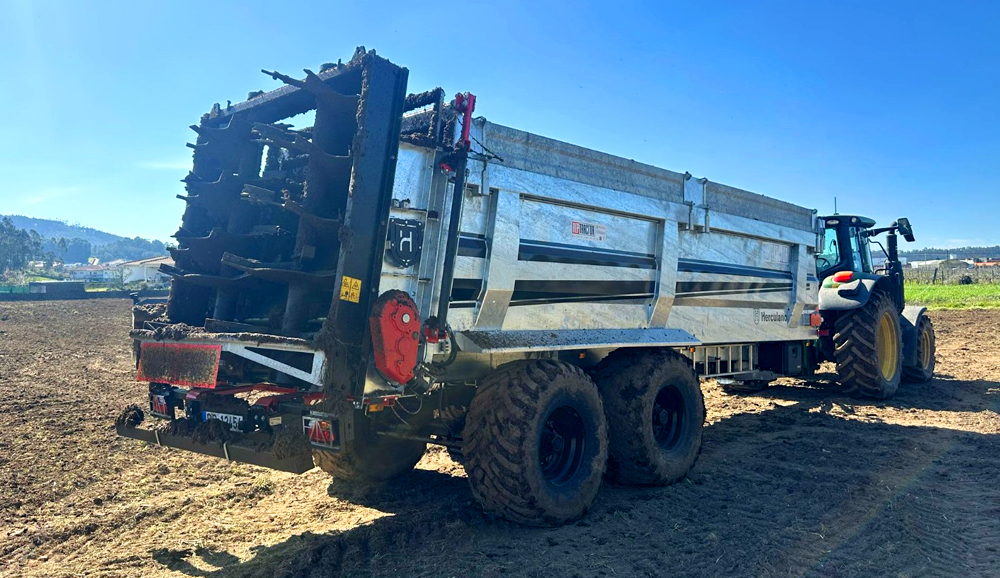DPA e VRT: Tecnologia para uma fertilização orgânica precisa e eficiente

A distribuição eficiente de estrumes e chorumes é fundamental para a correção química e estrutural do solo, garantindo maior produtividade e sustentabilidade agrícola. Duas das principais tecnologias utilizadas neste processo são o DPA (Débito Proporcional ao Avanço) e o VRT (Taxa Variável – Variable Rate Technology). Embora ambas tenham o objetivo de melhorar a aplicação de fertilizantes orgânicos, cada uma atua de forma diferente e pode ser utilizada em conjunto para otimizar os resultados.
DPA – Débito Proporcional ao Avanço
O DPA ajusta automaticamente o débito de distribuição em função da velocidade do trator, garantindo que a quantidade de estrume ou chorume aplicada por metro quadrado se mantenha constante, independentemente das variações de velocidade.
Vantagens
✔ Mantém uma dosagem uniforme e evita desperdícios.
✔ Simples de operar e ajustar.
✔ Reduz o risco de aplicação excessiva ou insuficiente em diferentes pontos da parcela.
Limitações
✖ Não considera as variações das necessidades do solo.
✖ Depende de calibração prévia para garantir precisão.
No contexto da correção química e estrutural do solo, o DPA assegura que a matéria orgânica e os nutrientes são aplicados de forma homogénea, promovendo melhorias na retenção de água, na estrutura do solo e na nutrição das culturas.
VRT – Taxa Variável
O VRT, por sua vez, ajusta a quantidade de fertilizante distribuída de acordo com as necessidades específicas de cada zona do solo, baseando-se em mapas de prescrição ou sensores em tempo real. Com essa tecnologia, é possível realizar uma aplicação mais eficiente e direcionada, corrigindo deficiências nutricionais e estruturais do solo com maior precisão.
Vantagens
✔ Ajusta a fertilização às necessidades reais do solo.
✔ Reduz custos e impactos ambientais ao evitar desperdícios.
✔ Melhora a eficiência dos nutrientes e a produtividade da cultura.
Limitações
✖ Requer análise prévia do solo e mapeamento da parcela.
✖ Investimento inicial mais elevado devido à necessidade de tecnologia embarcada.
Definição dos Ajustes de Fertilizante no Uso do VRT
Para tirar o máximo proveito do VRT, é necessário seguir um processo estruturado para definir previamente os ajustes de fertilizante.
- Análise do Solo e Mapeamento da Parcela
-
- Realizar amostragens de solo para identificar os níveis de nutrientes e matéria orgânica.
- Utilizar sensores, GPS, drones ou satélites para mapear as variações da fertilidade na parcela.
2. Criação do Mapa de Prescrição
-
- Com base na análise do solo, gerar um mapa de prescrição com as quantidades ideais de aplicação para cada zona.
- Considerar o histórico da parcela e os objetivos da fertilização.
3. Configuração do Sistema VRT no Equipamento
-
- Carregar o mapa de prescrição no controlador do espalhador ou da cisterna.
- Calibrar o sistema para garantir que a distribuição corresponde às recomendações do mapa.
4. Monitorização e Ajustes em Tempo Real
-
- Sensores NIR (Near Infrared) podem ser usados para medir a composição do chorume e ajustar a dose automaticamente.
- O operador pode acompanhar e corrigir a aplicação através do terminal do equipamento.
Resumindo, tanto o DPA quanto o VRT desempenham um papel essencial na gestão da fertilização orgânica. O DPA assegura uma distribuição homogénea e ajustada à velocidade do trator, enquanto o VRT permite uma aplicação mais precisa e otimizada, corrigindo deficiências específicas do solo. A combinação destas tecnologias melhora a eficiência dos fertilizantes orgânicos, promovendo um solo mais fértil, produtivo e sustentável.



